Commercial Law Assignment: Australian Legal System and Case Studies
VerifiedAdded on 2019/11/26
|13
|3415
|121
Homework Assignment
AI Summary
This assignment delves into Australian commercial law, examining the legal system, contract law principles, and relevant case studies. It begins by exploring the nature of legal systems, particularly in primitive societies and the application of Professor Hart's theories within the Australian legal framework. The assignment further analyzes the key features of the Australian legal system, including its common law basis, division of powers, and the influence of Hart's legal philosophy. It then presents a detailed analysis of the case Fulham Partners LLC v National Australia Bank Ltd, focusing on contractual rights assignment and the necessity of consent. Finally, the assignment briefly addresses a hypothetical scenario concerning contract termination and the concept of the 'act of God'. The document provides an overview of key legal concepts and their practical application within the Australian commercial law context.
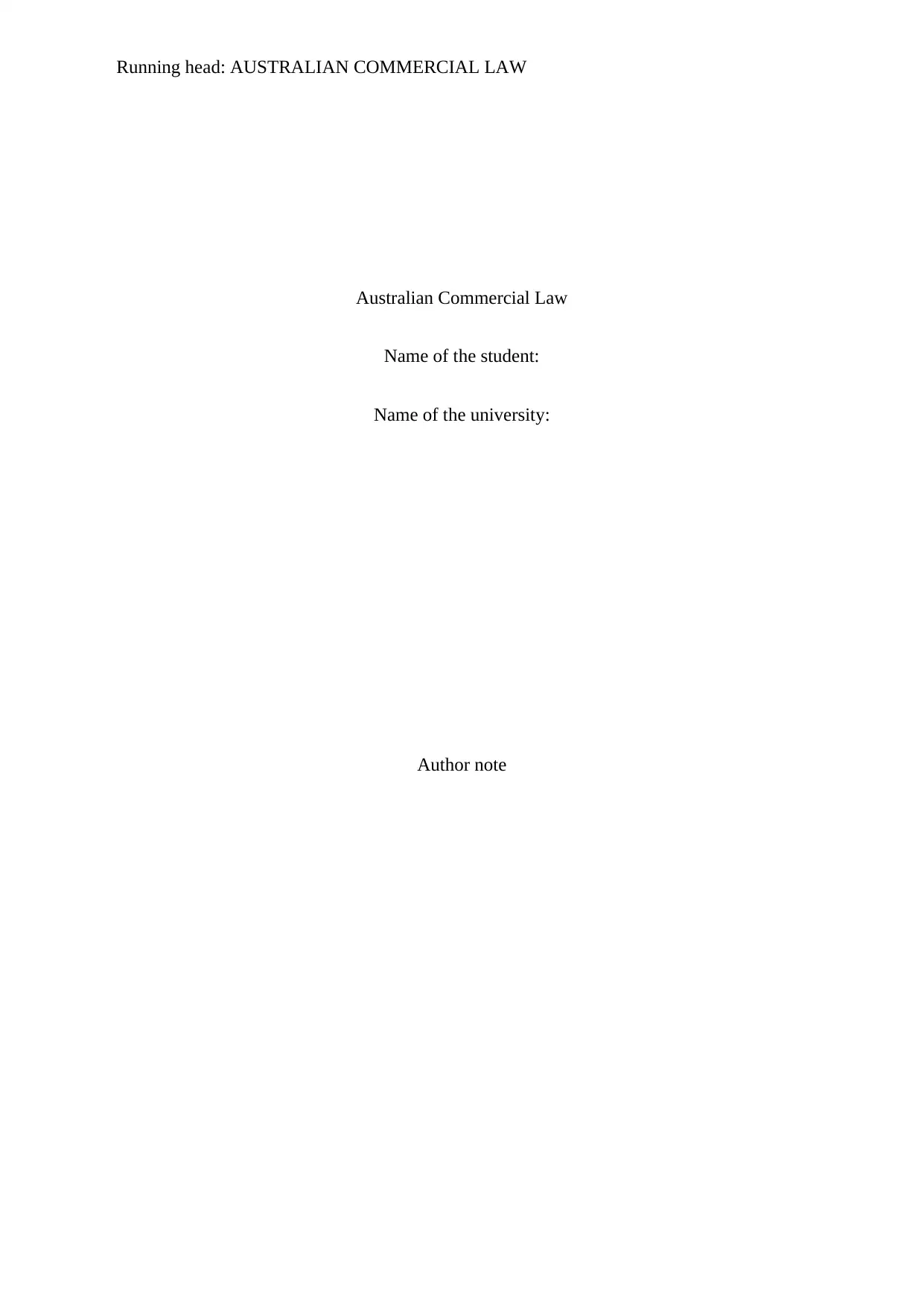
Running head: AUSTRALIAN COMMERCIAL LAW
Australian Commercial Law
Name of the student:
Name of the university:
Author note
Australian Commercial Law
Name of the student:
Name of the university:
Author note
Paraphrase This Document
Need a fresh take? Get an instant paraphrase of this document with our AI Paraphraser
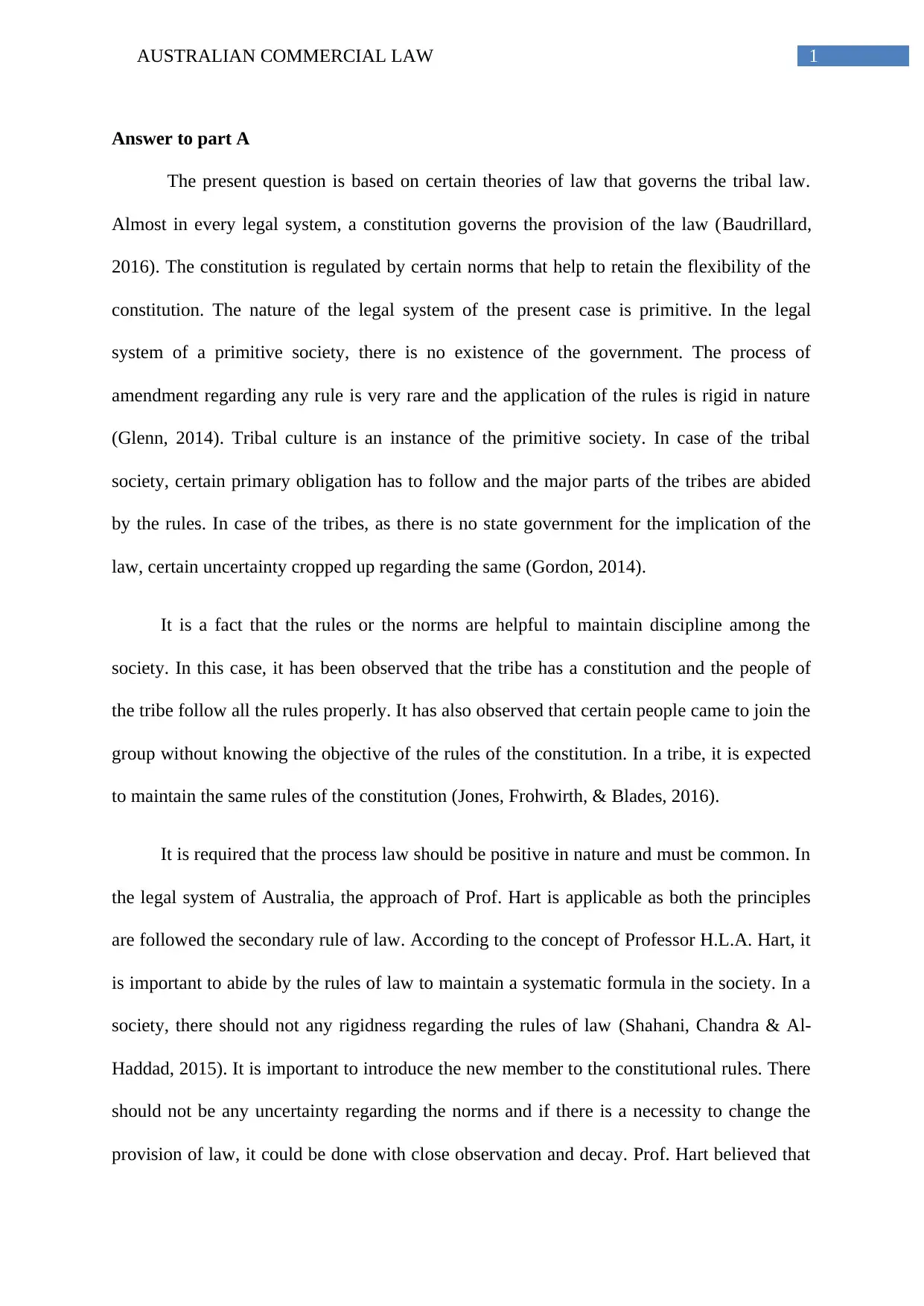
1AUSTRALIAN COMMERCIAL LAW
Answer to part A
The present question is based on certain theories of law that governs the tribal law.
Almost in every legal system, a constitution governs the provision of the law (Baudrillard,
2016). The constitution is regulated by certain norms that help to retain the flexibility of the
constitution. The nature of the legal system of the present case is primitive. In the legal
system of a primitive society, there is no existence of the government. The process of
amendment regarding any rule is very rare and the application of the rules is rigid in nature
(Glenn, 2014). Tribal culture is an instance of the primitive society. In case of the tribal
society, certain primary obligation has to follow and the major parts of the tribes are abided
by the rules. In case of the tribes, as there is no state government for the implication of the
law, certain uncertainty cropped up regarding the same (Gordon, 2014).
It is a fact that the rules or the norms are helpful to maintain discipline among the
society. In this case, it has been observed that the tribe has a constitution and the people of
the tribe follow all the rules properly. It has also observed that certain people came to join the
group without knowing the objective of the rules of the constitution. In a tribe, it is expected
to maintain the same rules of the constitution (Jones, Frohwirth, & Blades, 2016).
It is required that the process law should be positive in nature and must be common. In
the legal system of Australia, the approach of Prof. Hart is applicable as both the principles
are followed the secondary rule of law. According to the concept of Professor H.L.A. Hart, it
is important to abide by the rules of law to maintain a systematic formula in the society. In a
society, there should not any rigidness regarding the rules of law (Shahani, Chandra & Al-
Haddad, 2015). It is important to introduce the new member to the constitutional rules. There
should not be any uncertainty regarding the norms and if there is a necessity to change the
provision of law, it could be done with close observation and decay. Prof. Hart believed that
Answer to part A
The present question is based on certain theories of law that governs the tribal law.
Almost in every legal system, a constitution governs the provision of the law (Baudrillard,
2016). The constitution is regulated by certain norms that help to retain the flexibility of the
constitution. The nature of the legal system of the present case is primitive. In the legal
system of a primitive society, there is no existence of the government. The process of
amendment regarding any rule is very rare and the application of the rules is rigid in nature
(Glenn, 2014). Tribal culture is an instance of the primitive society. In case of the tribal
society, certain primary obligation has to follow and the major parts of the tribes are abided
by the rules. In case of the tribes, as there is no state government for the implication of the
law, certain uncertainty cropped up regarding the same (Gordon, 2014).
It is a fact that the rules or the norms are helpful to maintain discipline among the
society. In this case, it has been observed that the tribe has a constitution and the people of
the tribe follow all the rules properly. It has also observed that certain people came to join the
group without knowing the objective of the rules of the constitution. In a tribe, it is expected
to maintain the same rules of the constitution (Jones, Frohwirth, & Blades, 2016).
It is required that the process law should be positive in nature and must be common. In
the legal system of Australia, the approach of Prof. Hart is applicable as both the principles
are followed the secondary rule of law. According to the concept of Professor H.L.A. Hart, it
is important to abide by the rules of law to maintain a systematic formula in the society. In a
society, there should not any rigidness regarding the rules of law (Shahani, Chandra & Al-
Haddad, 2015). It is important to introduce the new member to the constitutional rules. There
should not be any uncertainty regarding the norms and if there is a necessity to change the
provision of law, it could be done with close observation and decay. Prof. Hart believed that
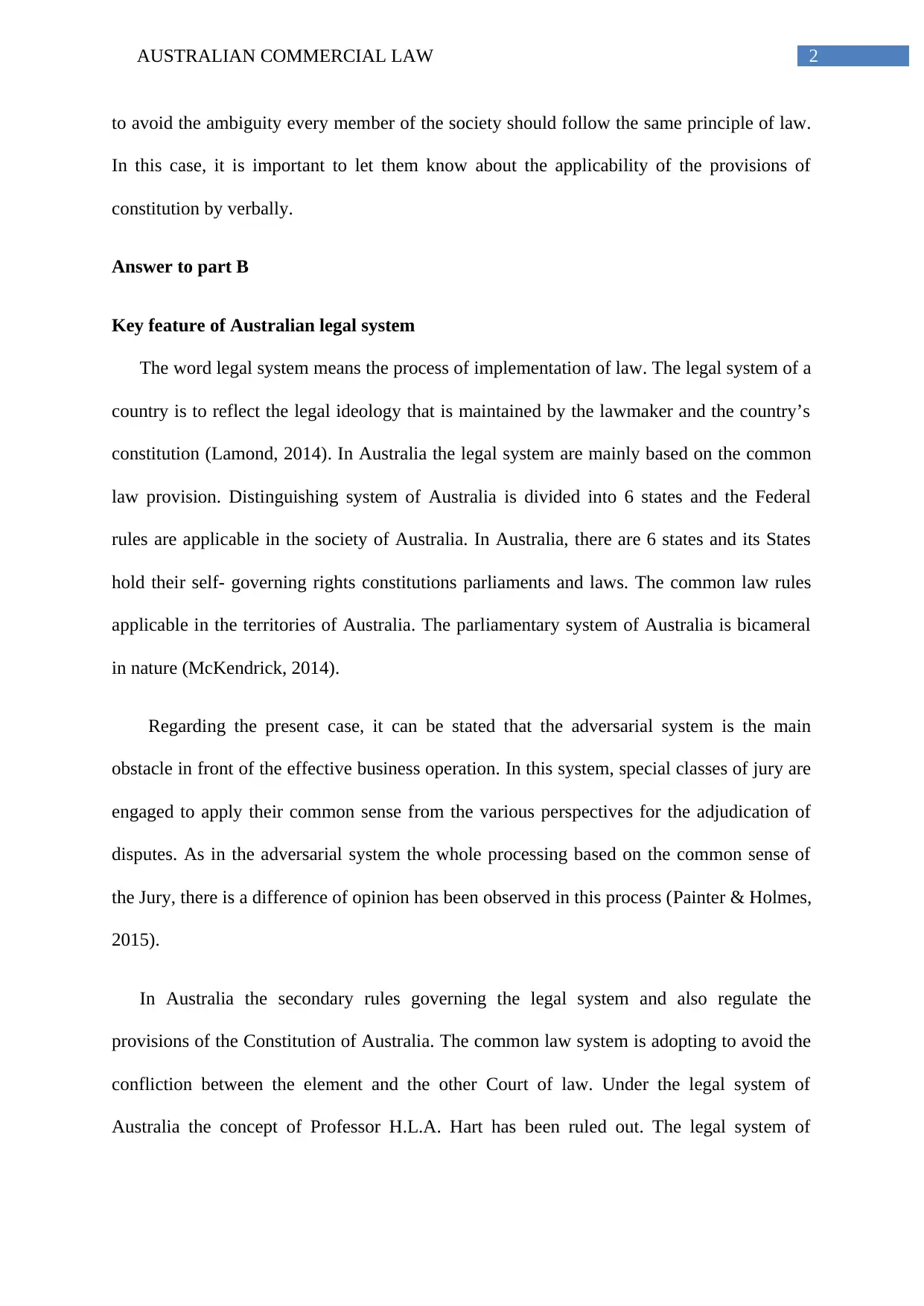
2AUSTRALIAN COMMERCIAL LAW
to avoid the ambiguity every member of the society should follow the same principle of law.
In this case, it is important to let them know about the applicability of the provisions of
constitution by verbally.
Answer to part B
Key feature of Australian legal system
The word legal system means the process of implementation of law. The legal system of a
country is to reflect the legal ideology that is maintained by the lawmaker and the country’s
constitution (Lamond, 2014). In Australia the legal system are mainly based on the common
law provision. Distinguishing system of Australia is divided into 6 states and the Federal
rules are applicable in the society of Australia. In Australia, there are 6 states and its States
hold their self- governing rights constitutions parliaments and laws. The common law rules
applicable in the territories of Australia. The parliamentary system of Australia is bicameral
in nature (McKendrick, 2014).
Regarding the present case, it can be stated that the adversarial system is the main
obstacle in front of the effective business operation. In this system, special classes of jury are
engaged to apply their common sense from the various perspectives for the adjudication of
disputes. As in the adversarial system the whole processing based on the common sense of
the Jury, there is a difference of opinion has been observed in this process (Painter & Holmes,
2015).
In Australia the secondary rules governing the legal system and also regulate the
provisions of the Constitution of Australia. The common law system is adopting to avoid the
confliction between the element and the other Court of law. Under the legal system of
Australia the concept of Professor H.L.A. Hart has been ruled out. The legal system of
to avoid the ambiguity every member of the society should follow the same principle of law.
In this case, it is important to let them know about the applicability of the provisions of
constitution by verbally.
Answer to part B
Key feature of Australian legal system
The word legal system means the process of implementation of law. The legal system of a
country is to reflect the legal ideology that is maintained by the lawmaker and the country’s
constitution (Lamond, 2014). In Australia the legal system are mainly based on the common
law provision. Distinguishing system of Australia is divided into 6 states and the Federal
rules are applicable in the society of Australia. In Australia, there are 6 states and its States
hold their self- governing rights constitutions parliaments and laws. The common law rules
applicable in the territories of Australia. The parliamentary system of Australia is bicameral
in nature (McKendrick, 2014).
Regarding the present case, it can be stated that the adversarial system is the main
obstacle in front of the effective business operation. In this system, special classes of jury are
engaged to apply their common sense from the various perspectives for the adjudication of
disputes. As in the adversarial system the whole processing based on the common sense of
the Jury, there is a difference of opinion has been observed in this process (Painter & Holmes,
2015).
In Australia the secondary rules governing the legal system and also regulate the
provisions of the Constitution of Australia. The common law system is adopting to avoid the
confliction between the element and the other Court of law. Under the legal system of
Australia the concept of Professor H.L.A. Hart has been ruled out. The legal system of
⊘ This is a preview!⊘
Do you want full access?
Subscribe today to unlock all pages.

Trusted by 1+ million students worldwide
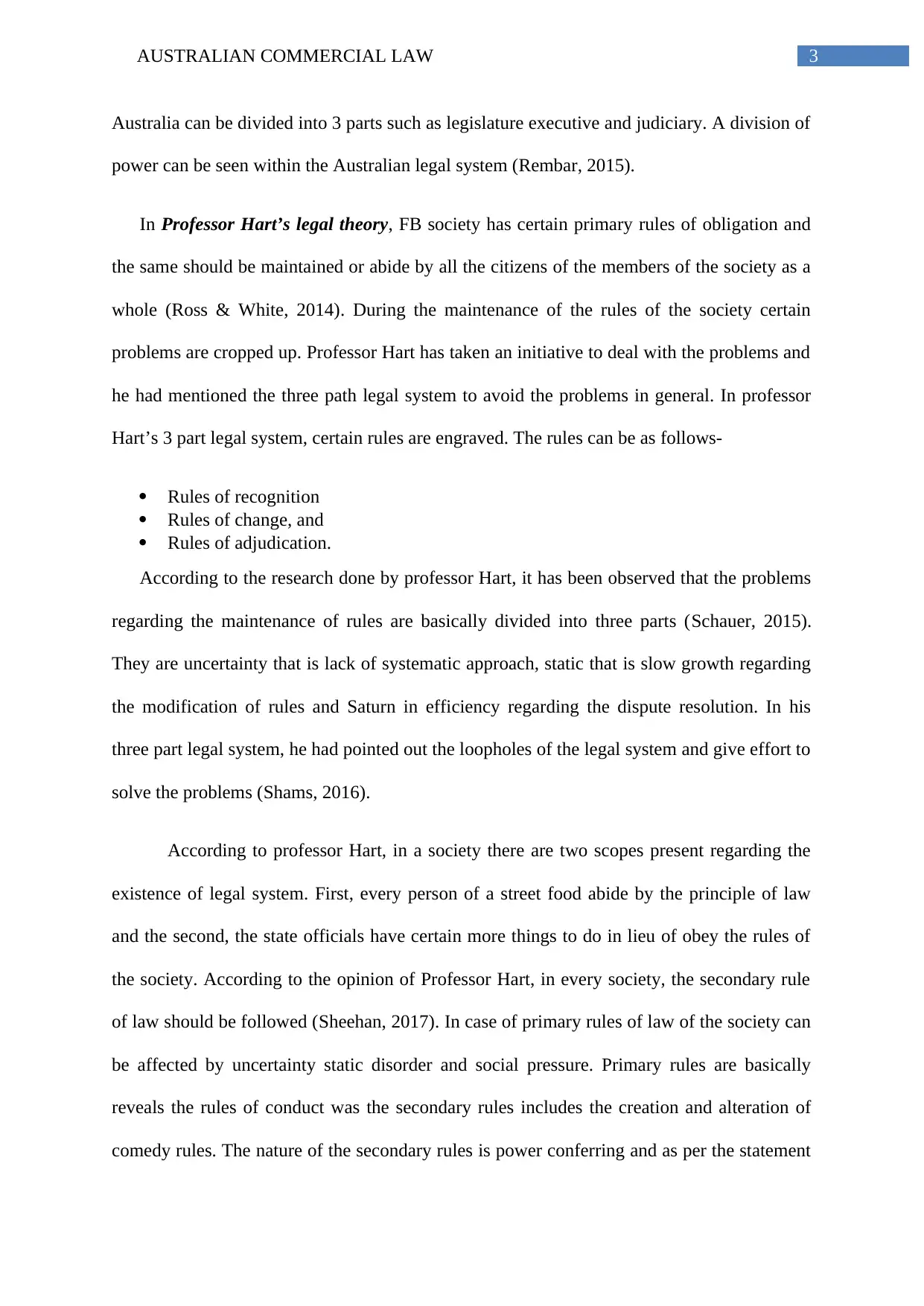
3AUSTRALIAN COMMERCIAL LAW
Australia can be divided into 3 parts such as legislature executive and judiciary. A division of
power can be seen within the Australian legal system (Rembar, 2015).
In Professor Hart’s legal theory, FB society has certain primary rules of obligation and
the same should be maintained or abide by all the citizens of the members of the society as a
whole (Ross & White, 2014). During the maintenance of the rules of the society certain
problems are cropped up. Professor Hart has taken an initiative to deal with the problems and
he had mentioned the three path legal system to avoid the problems in general. In professor
Hart’s 3 part legal system, certain rules are engraved. The rules can be as follows-
Rules of recognition
Rules of change, and
Rules of adjudication.
According to the research done by professor Hart, it has been observed that the problems
regarding the maintenance of rules are basically divided into three parts (Schauer, 2015).
They are uncertainty that is lack of systematic approach, static that is slow growth regarding
the modification of rules and Saturn in efficiency regarding the dispute resolution. In his
three part legal system, he had pointed out the loopholes of the legal system and give effort to
solve the problems (Shams, 2016).
According to professor Hart, in a society there are two scopes present regarding the
existence of legal system. First, every person of a street food abide by the principle of law
and the second, the state officials have certain more things to do in lieu of obey the rules of
the society. According to the opinion of Professor Hart, in every society, the secondary rule
of law should be followed (Sheehan, 2017). In case of primary rules of law of the society can
be affected by uncertainty static disorder and social pressure. Primary rules are basically
reveals the rules of conduct was the secondary rules includes the creation and alteration of
comedy rules. The nature of the secondary rules is power conferring and as per the statement
Australia can be divided into 3 parts such as legislature executive and judiciary. A division of
power can be seen within the Australian legal system (Rembar, 2015).
In Professor Hart’s legal theory, FB society has certain primary rules of obligation and
the same should be maintained or abide by all the citizens of the members of the society as a
whole (Ross & White, 2014). During the maintenance of the rules of the society certain
problems are cropped up. Professor Hart has taken an initiative to deal with the problems and
he had mentioned the three path legal system to avoid the problems in general. In professor
Hart’s 3 part legal system, certain rules are engraved. The rules can be as follows-
Rules of recognition
Rules of change, and
Rules of adjudication.
According to the research done by professor Hart, it has been observed that the problems
regarding the maintenance of rules are basically divided into three parts (Schauer, 2015).
They are uncertainty that is lack of systematic approach, static that is slow growth regarding
the modification of rules and Saturn in efficiency regarding the dispute resolution. In his
three part legal system, he had pointed out the loopholes of the legal system and give effort to
solve the problems (Shams, 2016).
According to professor Hart, in a society there are two scopes present regarding the
existence of legal system. First, every person of a street food abide by the principle of law
and the second, the state officials have certain more things to do in lieu of obey the rules of
the society. According to the opinion of Professor Hart, in every society, the secondary rule
of law should be followed (Sheehan, 2017). In case of primary rules of law of the society can
be affected by uncertainty static disorder and social pressure. Primary rules are basically
reveals the rules of conduct was the secondary rules includes the creation and alteration of
comedy rules. The nature of the secondary rules is power conferring and as per the statement
Paraphrase This Document
Need a fresh take? Get an instant paraphrase of this document with our AI Paraphraser
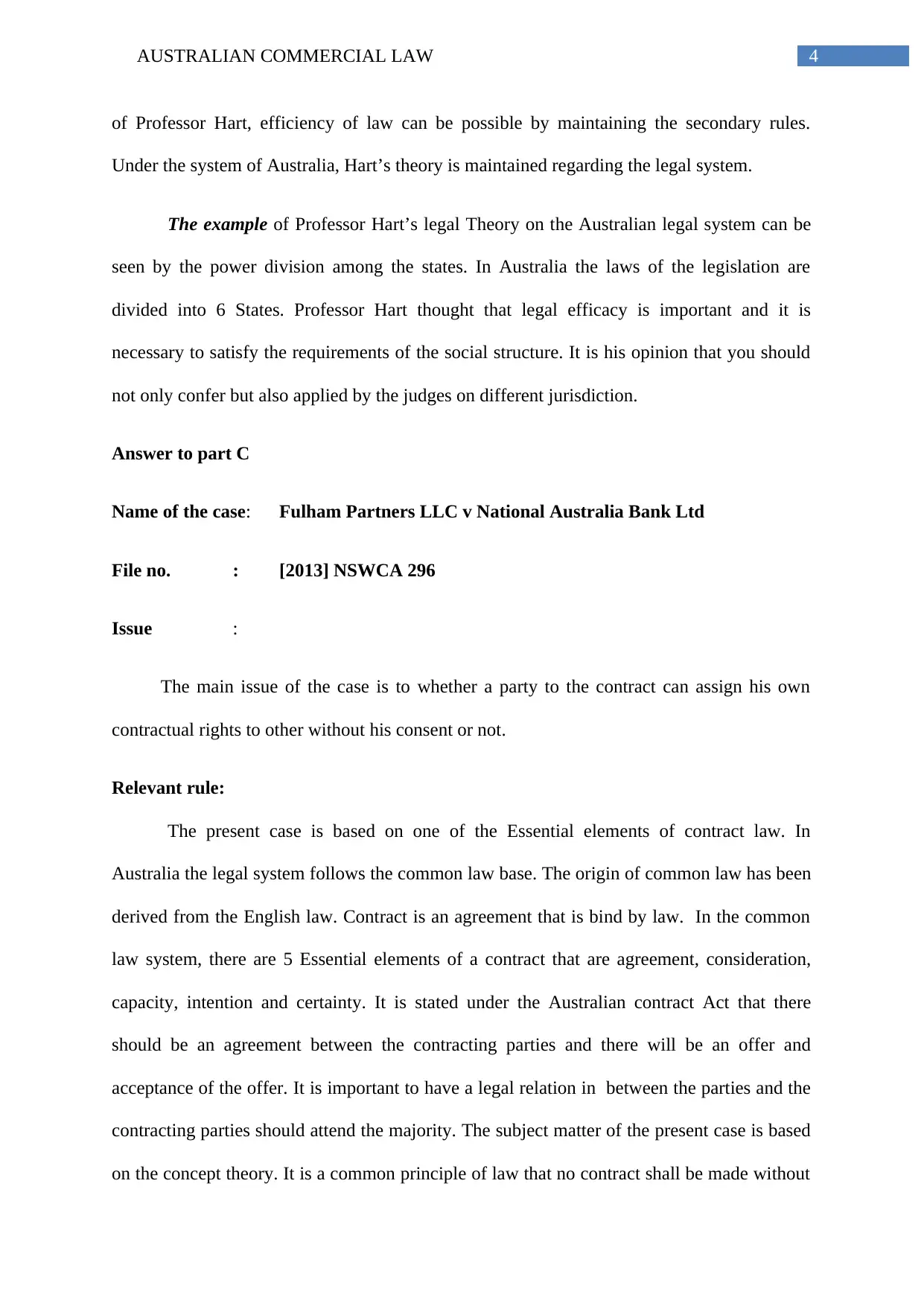
4AUSTRALIAN COMMERCIAL LAW
of Professor Hart, efficiency of law can be possible by maintaining the secondary rules.
Under the system of Australia, Hart’s theory is maintained regarding the legal system.
The example of Professor Hart’s legal Theory on the Australian legal system can be
seen by the power division among the states. In Australia the laws of the legislation are
divided into 6 States. Professor Hart thought that legal efficacy is important and it is
necessary to satisfy the requirements of the social structure. It is his opinion that you should
not only confer but also applied by the judges on different jurisdiction.
Answer to part C
Name of the case: Fulham Partners LLC v National Australia Bank Ltd
File no. : [2013] NSWCA 296
Issue :
The main issue of the case is to whether a party to the contract can assign his own
contractual rights to other without his consent or not.
Relevant rule:
The present case is based on one of the Essential elements of contract law. In
Australia the legal system follows the common law base. The origin of common law has been
derived from the English law. Contract is an agreement that is bind by law. In the common
law system, there are 5 Essential elements of a contract that are agreement, consideration,
capacity, intention and certainty. It is stated under the Australian contract Act that there
should be an agreement between the contracting parties and there will be an offer and
acceptance of the offer. It is important to have a legal relation in between the parties and the
contracting parties should attend the majority. The subject matter of the present case is based
on the concept theory. It is a common principle of law that no contract shall be made without
of Professor Hart, efficiency of law can be possible by maintaining the secondary rules.
Under the system of Australia, Hart’s theory is maintained regarding the legal system.
The example of Professor Hart’s legal Theory on the Australian legal system can be
seen by the power division among the states. In Australia the laws of the legislation are
divided into 6 States. Professor Hart thought that legal efficacy is important and it is
necessary to satisfy the requirements of the social structure. It is his opinion that you should
not only confer but also applied by the judges on different jurisdiction.
Answer to part C
Name of the case: Fulham Partners LLC v National Australia Bank Ltd
File no. : [2013] NSWCA 296
Issue :
The main issue of the case is to whether a party to the contract can assign his own
contractual rights to other without his consent or not.
Relevant rule:
The present case is based on one of the Essential elements of contract law. In
Australia the legal system follows the common law base. The origin of common law has been
derived from the English law. Contract is an agreement that is bind by law. In the common
law system, there are 5 Essential elements of a contract that are agreement, consideration,
capacity, intention and certainty. It is stated under the Australian contract Act that there
should be an agreement between the contracting parties and there will be an offer and
acceptance of the offer. It is important to have a legal relation in between the parties and the
contracting parties should attend the majority. The subject matter of the present case is based
on the concept theory. It is a common principle of law that no contract shall be made without
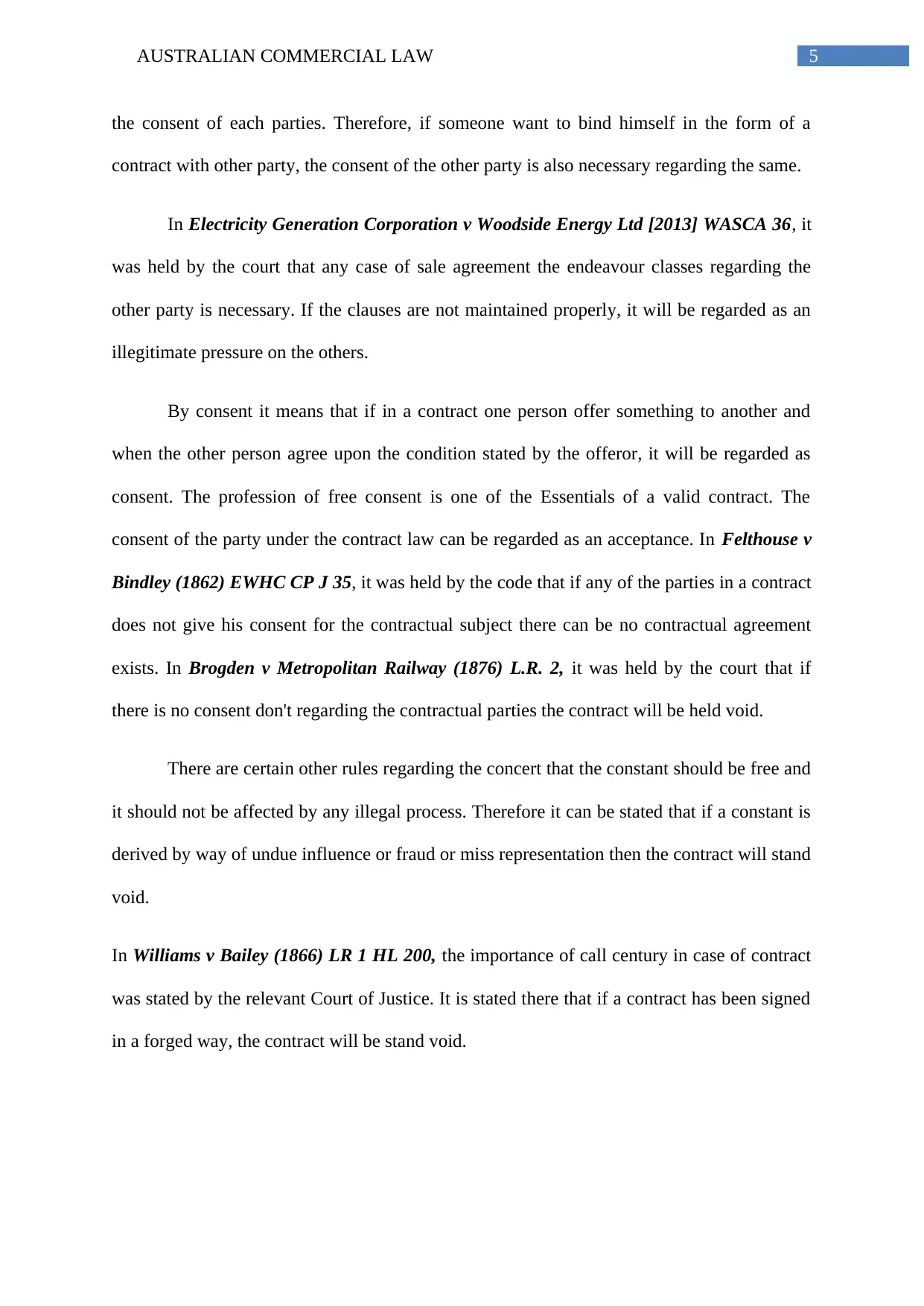
5AUSTRALIAN COMMERCIAL LAW
the consent of each parties. Therefore, if someone want to bind himself in the form of a
contract with other party, the consent of the other party is also necessary regarding the same.
In Electricity Generation Corporation v Woodside Energy Ltd [2013] WASCA 36, it
was held by the court that any case of sale agreement the endeavour classes regarding the
other party is necessary. If the clauses are not maintained properly, it will be regarded as an
illegitimate pressure on the others.
By consent it means that if in a contract one person offer something to another and
when the other person agree upon the condition stated by the offeror, it will be regarded as
consent. The profession of free consent is one of the Essentials of a valid contract. The
consent of the party under the contract law can be regarded as an acceptance. In Felthouse v
Bindley (1862) EWHC CP J 35, it was held by the code that if any of the parties in a contract
does not give his consent for the contractual subject there can be no contractual agreement
exists. In Brogden v Metropolitan Railway (1876) L.R. 2, it was held by the court that if
there is no consent don't regarding the contractual parties the contract will be held void.
There are certain other rules regarding the concert that the constant should be free and
it should not be affected by any illegal process. Therefore it can be stated that if a constant is
derived by way of undue influence or fraud or miss representation then the contract will stand
void.
In Williams v Bailey (1866) LR 1 HL 200, the importance of call century in case of contract
was stated by the relevant Court of Justice. It is stated there that if a contract has been signed
in a forged way, the contract will be stand void.
the consent of each parties. Therefore, if someone want to bind himself in the form of a
contract with other party, the consent of the other party is also necessary regarding the same.
In Electricity Generation Corporation v Woodside Energy Ltd [2013] WASCA 36, it
was held by the court that any case of sale agreement the endeavour classes regarding the
other party is necessary. If the clauses are not maintained properly, it will be regarded as an
illegitimate pressure on the others.
By consent it means that if in a contract one person offer something to another and
when the other person agree upon the condition stated by the offeror, it will be regarded as
consent. The profession of free consent is one of the Essentials of a valid contract. The
consent of the party under the contract law can be regarded as an acceptance. In Felthouse v
Bindley (1862) EWHC CP J 35, it was held by the code that if any of the parties in a contract
does not give his consent for the contractual subject there can be no contractual agreement
exists. In Brogden v Metropolitan Railway (1876) L.R. 2, it was held by the court that if
there is no consent don't regarding the contractual parties the contract will be held void.
There are certain other rules regarding the concert that the constant should be free and
it should not be affected by any illegal process. Therefore it can be stated that if a constant is
derived by way of undue influence or fraud or miss representation then the contract will stand
void.
In Williams v Bailey (1866) LR 1 HL 200, the importance of call century in case of contract
was stated by the relevant Court of Justice. It is stated there that if a contract has been signed
in a forged way, the contract will be stand void.
⊘ This is a preview!⊘
Do you want full access?
Subscribe today to unlock all pages.

Trusted by 1+ million students worldwide
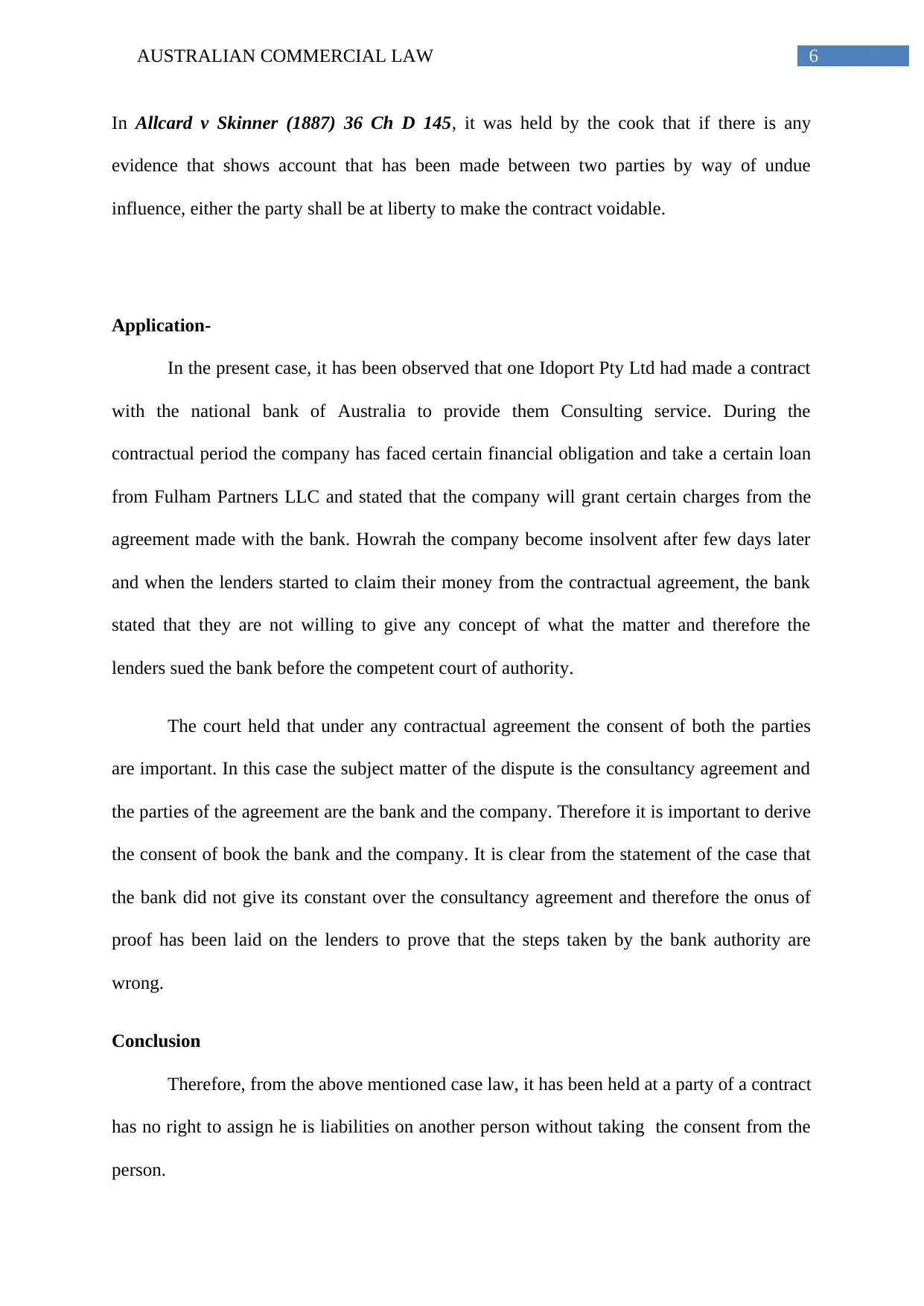
6AUSTRALIAN COMMERCIAL LAW
In Allcard v Skinner (1887) 36 Ch D 145, it was held by the cook that if there is any
evidence that shows account that has been made between two parties by way of undue
influence, either the party shall be at liberty to make the contract voidable.
Application-
In the present case, it has been observed that one Idoport Pty Ltd had made a contract
with the national bank of Australia to provide them Consulting service. During the
contractual period the company has faced certain financial obligation and take a certain loan
from Fulham Partners LLC and stated that the company will grant certain charges from the
agreement made with the bank. Howrah the company become insolvent after few days later
and when the lenders started to claim their money from the contractual agreement, the bank
stated that they are not willing to give any concept of what the matter and therefore the
lenders sued the bank before the competent court of authority.
The court held that under any contractual agreement the consent of both the parties
are important. In this case the subject matter of the dispute is the consultancy agreement and
the parties of the agreement are the bank and the company. Therefore it is important to derive
the consent of book the bank and the company. It is clear from the statement of the case that
the bank did not give its constant over the consultancy agreement and therefore the onus of
proof has been laid on the lenders to prove that the steps taken by the bank authority are
wrong.
Conclusion
Therefore, from the above mentioned case law, it has been held at a party of a contract
has no right to assign he is liabilities on another person without taking the consent from the
person.
In Allcard v Skinner (1887) 36 Ch D 145, it was held by the cook that if there is any
evidence that shows account that has been made between two parties by way of undue
influence, either the party shall be at liberty to make the contract voidable.
Application-
In the present case, it has been observed that one Idoport Pty Ltd had made a contract
with the national bank of Australia to provide them Consulting service. During the
contractual period the company has faced certain financial obligation and take a certain loan
from Fulham Partners LLC and stated that the company will grant certain charges from the
agreement made with the bank. Howrah the company become insolvent after few days later
and when the lenders started to claim their money from the contractual agreement, the bank
stated that they are not willing to give any concept of what the matter and therefore the
lenders sued the bank before the competent court of authority.
The court held that under any contractual agreement the consent of both the parties
are important. In this case the subject matter of the dispute is the consultancy agreement and
the parties of the agreement are the bank and the company. Therefore it is important to derive
the consent of book the bank and the company. It is clear from the statement of the case that
the bank did not give its constant over the consultancy agreement and therefore the onus of
proof has been laid on the lenders to prove that the steps taken by the bank authority are
wrong.
Conclusion
Therefore, from the above mentioned case law, it has been held at a party of a contract
has no right to assign he is liabilities on another person without taking the consent from the
person.
Paraphrase This Document
Need a fresh take? Get an instant paraphrase of this document with our AI Paraphraser
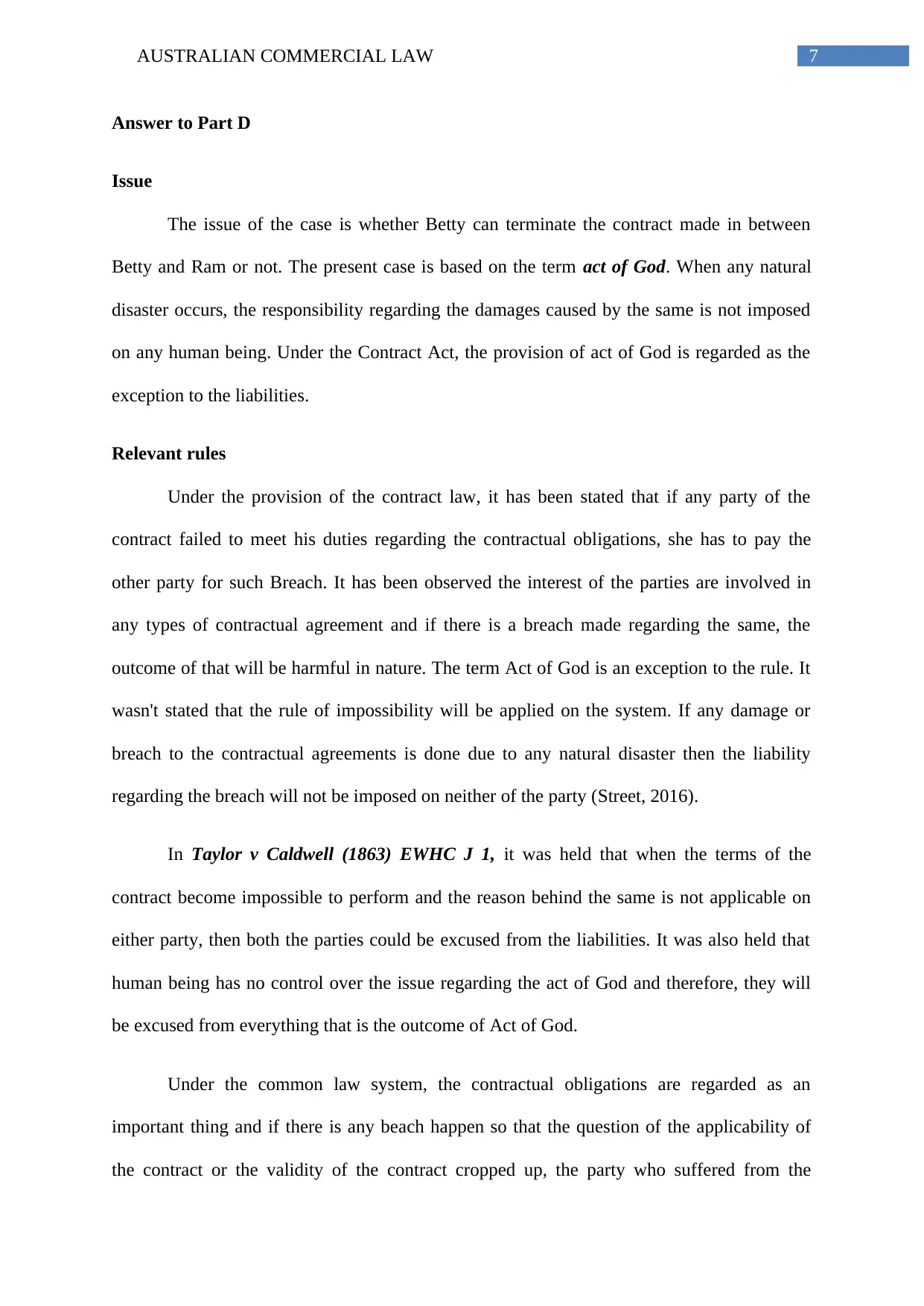
7AUSTRALIAN COMMERCIAL LAW
Answer to Part D
Issue
The issue of the case is whether Betty can terminate the contract made in between
Betty and Ram or not. The present case is based on the term act of God. When any natural
disaster occurs, the responsibility regarding the damages caused by the same is not imposed
on any human being. Under the Contract Act, the provision of act of God is regarded as the
exception to the liabilities.
Relevant rules
Under the provision of the contract law, it has been stated that if any party of the
contract failed to meet his duties regarding the contractual obligations, she has to pay the
other party for such Breach. It has been observed the interest of the parties are involved in
any types of contractual agreement and if there is a breach made regarding the same, the
outcome of that will be harmful in nature. The term Act of God is an exception to the rule. It
wasn't stated that the rule of impossibility will be applied on the system. If any damage or
breach to the contractual agreements is done due to any natural disaster then the liability
regarding the breach will not be imposed on neither of the party (Street, 2016).
In Taylor v Caldwell (1863) EWHC J 1, it was held that when the terms of the
contract become impossible to perform and the reason behind the same is not applicable on
either party, then both the parties could be excused from the liabilities. It was also held that
human being has no control over the issue regarding the act of God and therefore, they will
be excused from everything that is the outcome of Act of God.
Under the common law system, the contractual obligations are regarded as an
important thing and if there is any beach happen so that the question of the applicability of
the contract or the validity of the contract cropped up, the party who suffered from the
Answer to Part D
Issue
The issue of the case is whether Betty can terminate the contract made in between
Betty and Ram or not. The present case is based on the term act of God. When any natural
disaster occurs, the responsibility regarding the damages caused by the same is not imposed
on any human being. Under the Contract Act, the provision of act of God is regarded as the
exception to the liabilities.
Relevant rules
Under the provision of the contract law, it has been stated that if any party of the
contract failed to meet his duties regarding the contractual obligations, she has to pay the
other party for such Breach. It has been observed the interest of the parties are involved in
any types of contractual agreement and if there is a breach made regarding the same, the
outcome of that will be harmful in nature. The term Act of God is an exception to the rule. It
wasn't stated that the rule of impossibility will be applied on the system. If any damage or
breach to the contractual agreements is done due to any natural disaster then the liability
regarding the breach will not be imposed on neither of the party (Street, 2016).
In Taylor v Caldwell (1863) EWHC J 1, it was held that when the terms of the
contract become impossible to perform and the reason behind the same is not applicable on
either party, then both the parties could be excused from the liabilities. It was also held that
human being has no control over the issue regarding the act of God and therefore, they will
be excused from everything that is the outcome of Act of God.
Under the common law system, the contractual obligations are regarded as an
important thing and if there is any beach happen so that the question of the applicability of
the contract or the validity of the contract cropped up, the party who suffered from the
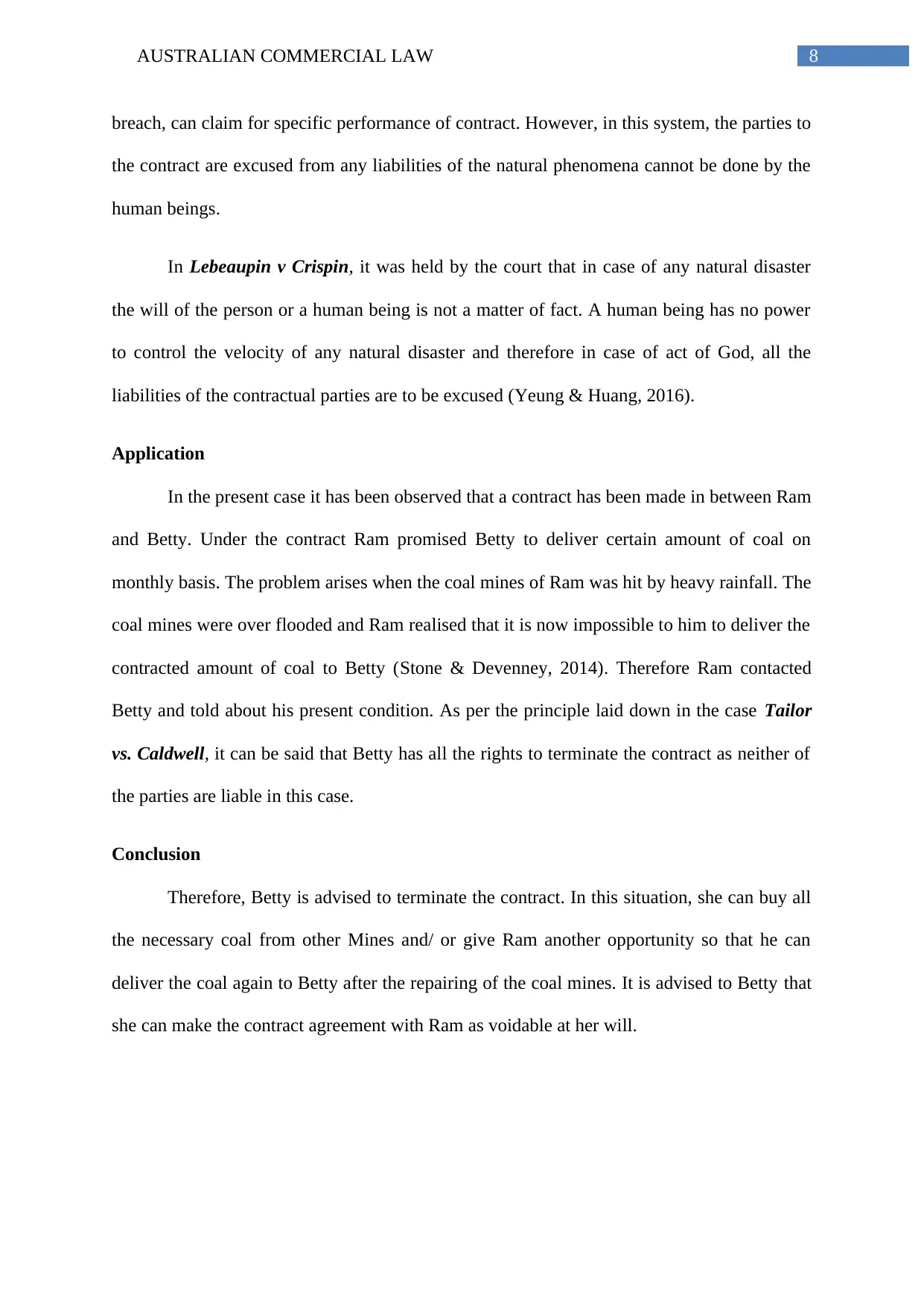
8AUSTRALIAN COMMERCIAL LAW
breach, can claim for specific performance of contract. However, in this system, the parties to
the contract are excused from any liabilities of the natural phenomena cannot be done by the
human beings.
In Lebeaupin v Crispin, it was held by the court that in case of any natural disaster
the will of the person or a human being is not a matter of fact. A human being has no power
to control the velocity of any natural disaster and therefore in case of act of God, all the
liabilities of the contractual parties are to be excused (Yeung & Huang, 2016).
Application
In the present case it has been observed that a contract has been made in between Ram
and Betty. Under the contract Ram promised Betty to deliver certain amount of coal on
monthly basis. The problem arises when the coal mines of Ram was hit by heavy rainfall. The
coal mines were over flooded and Ram realised that it is now impossible to him to deliver the
contracted amount of coal to Betty (Stone & Devenney, 2014). Therefore Ram contacted
Betty and told about his present condition. As per the principle laid down in the case Tailor
vs. Caldwell, it can be said that Betty has all the rights to terminate the contract as neither of
the parties are liable in this case.
Conclusion
Therefore, Betty is advised to terminate the contract. In this situation, she can buy all
the necessary coal from other Mines and/ or give Ram another opportunity so that he can
deliver the coal again to Betty after the repairing of the coal mines. It is advised to Betty that
she can make the contract agreement with Ram as voidable at her will.
breach, can claim for specific performance of contract. However, in this system, the parties to
the contract are excused from any liabilities of the natural phenomena cannot be done by the
human beings.
In Lebeaupin v Crispin, it was held by the court that in case of any natural disaster
the will of the person or a human being is not a matter of fact. A human being has no power
to control the velocity of any natural disaster and therefore in case of act of God, all the
liabilities of the contractual parties are to be excused (Yeung & Huang, 2016).
Application
In the present case it has been observed that a contract has been made in between Ram
and Betty. Under the contract Ram promised Betty to deliver certain amount of coal on
monthly basis. The problem arises when the coal mines of Ram was hit by heavy rainfall. The
coal mines were over flooded and Ram realised that it is now impossible to him to deliver the
contracted amount of coal to Betty (Stone & Devenney, 2014). Therefore Ram contacted
Betty and told about his present condition. As per the principle laid down in the case Tailor
vs. Caldwell, it can be said that Betty has all the rights to terminate the contract as neither of
the parties are liable in this case.
Conclusion
Therefore, Betty is advised to terminate the contract. In this situation, she can buy all
the necessary coal from other Mines and/ or give Ram another opportunity so that he can
deliver the coal again to Betty after the repairing of the coal mines. It is advised to Betty that
she can make the contract agreement with Ram as voidable at her will.
⊘ This is a preview!⊘
Do you want full access?
Subscribe today to unlock all pages.

Trusted by 1+ million students worldwide
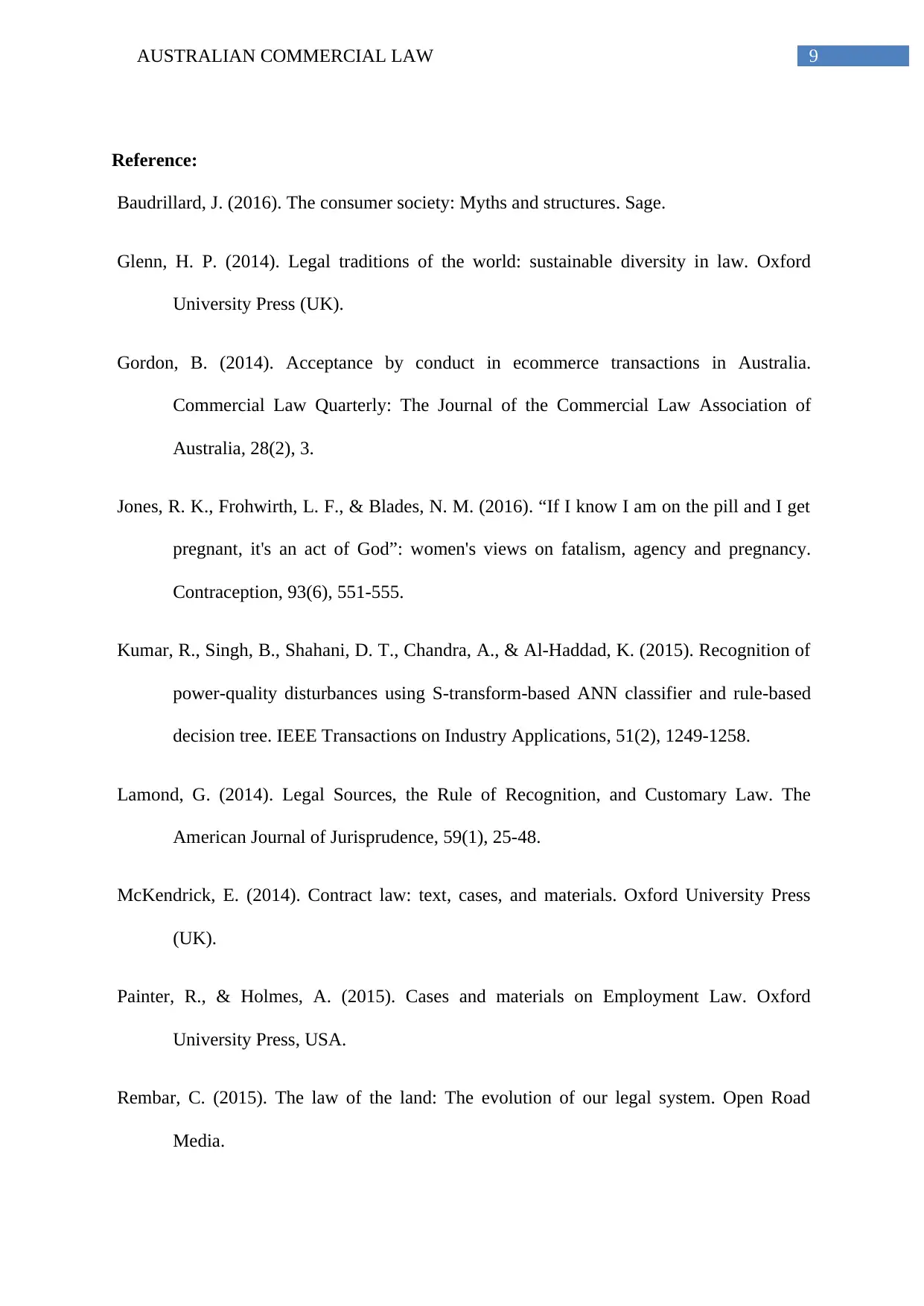
9AUSTRALIAN COMMERCIAL LAW
Reference:
Baudrillard, J. (2016). The consumer society: Myths and structures. Sage.
Glenn, H. P. (2014). Legal traditions of the world: sustainable diversity in law. Oxford
University Press (UK).
Gordon, B. (2014). Acceptance by conduct in ecommerce transactions in Australia.
Commercial Law Quarterly: The Journal of the Commercial Law Association of
Australia, 28(2), 3.
Jones, R. K., Frohwirth, L. F., & Blades, N. M. (2016). “If I know I am on the pill and I get
pregnant, it's an act of God”: women's views on fatalism, agency and pregnancy.
Contraception, 93(6), 551-555.
Kumar, R., Singh, B., Shahani, D. T., Chandra, A., & Al-Haddad, K. (2015). Recognition of
power-quality disturbances using S-transform-based ANN classifier and rule-based
decision tree. IEEE Transactions on Industry Applications, 51(2), 1249-1258.
Lamond, G. (2014). Legal Sources, the Rule of Recognition, and Customary Law. The
American Journal of Jurisprudence, 59(1), 25-48.
McKendrick, E. (2014). Contract law: text, cases, and materials. Oxford University Press
(UK).
Painter, R., & Holmes, A. (2015). Cases and materials on Employment Law. Oxford
University Press, USA.
Rembar, C. (2015). The law of the land: The evolution of our legal system. Open Road
Media.
Reference:
Baudrillard, J. (2016). The consumer society: Myths and structures. Sage.
Glenn, H. P. (2014). Legal traditions of the world: sustainable diversity in law. Oxford
University Press (UK).
Gordon, B. (2014). Acceptance by conduct in ecommerce transactions in Australia.
Commercial Law Quarterly: The Journal of the Commercial Law Association of
Australia, 28(2), 3.
Jones, R. K., Frohwirth, L. F., & Blades, N. M. (2016). “If I know I am on the pill and I get
pregnant, it's an act of God”: women's views on fatalism, agency and pregnancy.
Contraception, 93(6), 551-555.
Kumar, R., Singh, B., Shahani, D. T., Chandra, A., & Al-Haddad, K. (2015). Recognition of
power-quality disturbances using S-transform-based ANN classifier and rule-based
decision tree. IEEE Transactions on Industry Applications, 51(2), 1249-1258.
Lamond, G. (2014). Legal Sources, the Rule of Recognition, and Customary Law. The
American Journal of Jurisprudence, 59(1), 25-48.
McKendrick, E. (2014). Contract law: text, cases, and materials. Oxford University Press
(UK).
Painter, R., & Holmes, A. (2015). Cases and materials on Employment Law. Oxford
University Press, USA.
Rembar, C. (2015). The law of the land: The evolution of our legal system. Open Road
Media.
Paraphrase This Document
Need a fresh take? Get an instant paraphrase of this document with our AI Paraphraser
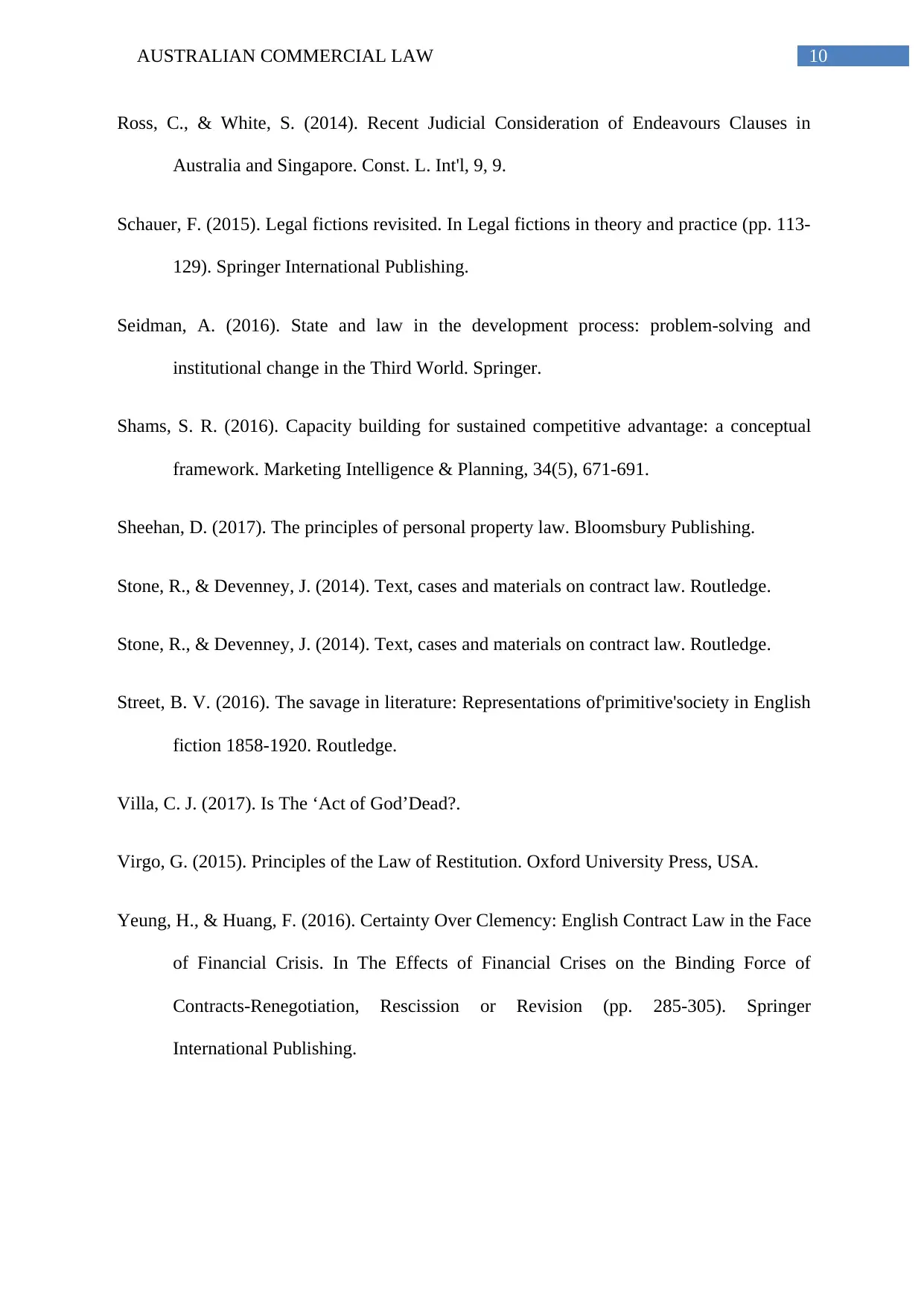
10AUSTRALIAN COMMERCIAL LAW
Ross, C., & White, S. (2014). Recent Judicial Consideration of Endeavours Clauses in
Australia and Singapore. Const. L. Int'l, 9, 9.
Schauer, F. (2015). Legal fictions revisited. In Legal fictions in theory and practice (pp. 113-
129). Springer International Publishing.
Seidman, A. (2016). State and law in the development process: problem-solving and
institutional change in the Third World. Springer.
Shams, S. R. (2016). Capacity building for sustained competitive advantage: a conceptual
framework. Marketing Intelligence & Planning, 34(5), 671-691.
Sheehan, D. (2017). The principles of personal property law. Bloomsbury Publishing.
Stone, R., & Devenney, J. (2014). Text, cases and materials on contract law. Routledge.
Stone, R., & Devenney, J. (2014). Text, cases and materials on contract law. Routledge.
Street, B. V. (2016). The savage in literature: Representations of'primitive'society in English
fiction 1858-1920. Routledge.
Villa, C. J. (2017). Is The ‘Act of God’Dead?.
Virgo, G. (2015). Principles of the Law of Restitution. Oxford University Press, USA.
Yeung, H., & Huang, F. (2016). Certainty Over Clemency: English Contract Law in the Face
of Financial Crisis. In The Effects of Financial Crises on the Binding Force of
Contracts-Renegotiation, Rescission or Revision (pp. 285-305). Springer
International Publishing.
Ross, C., & White, S. (2014). Recent Judicial Consideration of Endeavours Clauses in
Australia and Singapore. Const. L. Int'l, 9, 9.
Schauer, F. (2015). Legal fictions revisited. In Legal fictions in theory and practice (pp. 113-
129). Springer International Publishing.
Seidman, A. (2016). State and law in the development process: problem-solving and
institutional change in the Third World. Springer.
Shams, S. R. (2016). Capacity building for sustained competitive advantage: a conceptual
framework. Marketing Intelligence & Planning, 34(5), 671-691.
Sheehan, D. (2017). The principles of personal property law. Bloomsbury Publishing.
Stone, R., & Devenney, J. (2014). Text, cases and materials on contract law. Routledge.
Stone, R., & Devenney, J. (2014). Text, cases and materials on contract law. Routledge.
Street, B. V. (2016). The savage in literature: Representations of'primitive'society in English
fiction 1858-1920. Routledge.
Villa, C. J. (2017). Is The ‘Act of God’Dead?.
Virgo, G. (2015). Principles of the Law of Restitution. Oxford University Press, USA.
Yeung, H., & Huang, F. (2016). Certainty Over Clemency: English Contract Law in the Face
of Financial Crisis. In The Effects of Financial Crises on the Binding Force of
Contracts-Renegotiation, Rescission or Revision (pp. 285-305). Springer
International Publishing.

11AUSTRALIAN COMMERCIAL LAW
⊘ This is a preview!⊘
Do you want full access?
Subscribe today to unlock all pages.

Trusted by 1+ million students worldwide
1 out of 13
Related Documents
Your All-in-One AI-Powered Toolkit for Academic Success.
+13062052269
info@desklib.com
Available 24*7 on WhatsApp / Email
![[object Object]](/_next/static/media/star-bottom.7253800d.svg)
Unlock your academic potential
Copyright © 2020–2025 A2Z Services. All Rights Reserved. Developed and managed by ZUCOL.




